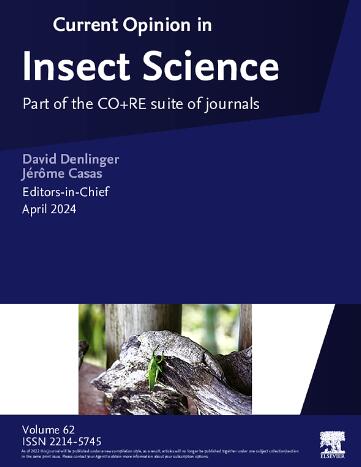白蚁社会中的合作与冲突。
IF 4.8
1区 农林科学
Q1 BIOLOGY
引用次数: 0
摘要
白蚁是社会性蟑螂,独立于社会性膜翅目昆虫(蚂蚁、蜜蜂和黄蜂)进化而来。因此,它们是二倍体生物,这对白蚁发生冲突有影响。在这里,我概述了白蚁之间潜在的冲突,并总结了测试其实际发生的研究。在白蚁中,性别比例的冲突在单倍体社会膜翅目昆虫中是典型的,但在白蚁中却普遍不存在。在其他条件相同的情况下,在一夫一妻制的白蚁群落中,没有基因冲突存在于自己的繁殖和帮助增加兄弟姐妹之间。潜在的白蚁冲突主要由两个主要原因引起:蚁群的非一夫一妻制和工蚁对蚁群继承的选择。非一夫一妻制发生在由一对以上的繁殖蚁群(主要是物种丰富的白蚁科,大部分工蚁不育)或邻近蚁群的融合(主要是有全能工蚁的木栖白蚁)。蜂群的非一夫一妻制可能有利于亲属歧视行为,但就像在社会膜翅目昆虫中一样,裙带关系的证据很少。在具有非不育工蜂的物种中,通常会发生关于继承出生繁殖位置的冲突,当它们的国王或王后死亡时,它们会发育成(新生育期)替代生殖并近亲繁殖。关于遗产的冲突似乎很普遍;然而,冲突解决机制可能已经进化,其中可能包括工人不育的进化。一般来说,白蚁的实验数据很少;要得出确切的结论还需要更多的研究。这样的研究应该考虑工人的生殖潜能(从全能到不育)、控制自己种姓命运的权力和生态之间的强烈相互作用。本文章由计算机程序翻译,如有差异,请以英文原文为准。
Cooperation and conflict in termite societies
Termites are social cockroaches that evolved eusociality independently from social Hymenoptera (ants, bees, and wasps). Thus, they are diploid organisms, and this has consequences for the occurrence of conflict in termites. Here, I outline the potential for conflict in termites and summarise studies that tested its actual occurrence. In termites, conflicts over the sex ratio, which are typical for haplodiploid social Hymenoptera, are generally absent. All else equal, in monogamous termite colonies, no genetic conflict exists over one’s own reproduction versus helping to raise siblings. Potential for conflict in termites mainly arises due to two main causes: nonmonogamy of colonies and options for colony inheritance by workers. Nonmonogamy occurs when colonies are founded by more than one pair of reproductives (mainly in the species-rich Termitidae with largely sterile workers) or due to fusion of neighbouring colonies (mainly in wood-dwelling termites with totipotent workers). Nonmonogamy of colonies could favour kin-discriminatory behaviour, but, like in social Hymenoptera, evidence for nepotism is rare. Conflict over inheritance of the natal breeding position commonly arises in species with nonsterile workers, which develop into (neotenic) replacement reproductives and inbreed when their king or queen dies. Conflict over inheritance seems to be widespread, yet conflict resolution mechanisms may have evolved, which might include the evolution of worker sterility. Generally, few experimental data exist for termites; more research is required for firm conclusions. Such studies should consider the strong interaction between workers’ reproductive potential (which varies from totipotent to sterile), power to control their own caste fate, and ecology.
求助全文
通过发布文献求助,成功后即可免费获取论文全文。
去求助
来源期刊

Current opinion in insect science
BIOLOGYECOLOGYENTOMOLOGY-ECOLOGY
CiteScore
10.40
自引率
1.90%
发文量
113
期刊介绍:
Current Opinion in Insect Science is a new systematic review journal that aims to provide specialists with a unique and educational platform to keep up–to–date with the expanding volume of information published in the field of Insect Science. As this is such a broad discipline, we have determined themed sections each of which is reviewed once a year.
The following 11 areas are covered by Current Opinion in Insect Science.
-Ecology
-Insect genomics
-Global Change Biology
-Molecular Physiology (Including Immunity)
-Pests and Resistance
-Parasites, Parasitoids and Biological Control
-Behavioural Ecology
-Development and Regulation
-Social Insects
-Neuroscience
-Vectors and Medical and Veterinary Entomology
There is also a section that changes every year to reflect hot topics in the field.
Section Editors, who are major authorities in their area, are appointed by the Editors of the journal. They divide their section into a number of topics, ensuring that the field is comprehensively covered and that all issues of current importance are emphasized. Section Editors commission articles from leading scientists on each topic that they have selected and the commissioned authors write short review articles in which they present recent developments in their subject, emphasizing the aspects that, in their opinion, are most important. In addition, they provide short annotations to the papers that they consider to be most interesting from all those published in their topic over the previous year.
 求助内容:
求助内容: 应助结果提醒方式:
应助结果提醒方式:


